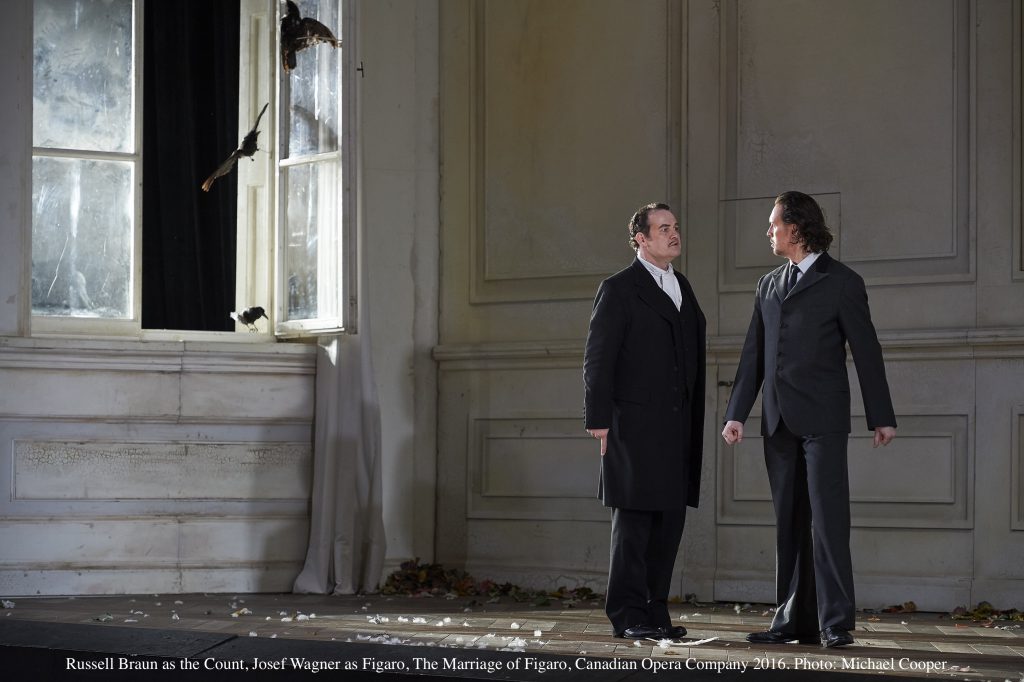Joseph II was nervous. His fellow monarch, Louis XVI of France, had banned performances of playwright Pierre-Augustin Caron de Beaumarchais’ blistering, pro-Revolutionary satire, la Folle journée, ou le Mariage de Figaro (The Mad Day, or The Marriage of Figaro). Yet here was Wolfgang Amadeus Mozart, the irrepressible Viennese musical one-off, brilliant but uncontrollable, clamouring to set the timely comedy of manners as opera buffa. True, the libretto by resident court poet Lorenzo da Ponte had already passed Imperial muster. The bulk of anti-autocratic sentiment had been largely expunged. But a whiff of dangerous democratic idealism still lingered in the corners of da Ponte’s text. Mozart, too, was well known for his humanist sensibilities, not to mention his taste for more sensual earthy pleasures.
The opera-obsessed Holy Roman Emperor took a chance. Regal permission was granted. Mozart hurled himself at the commission and on May 1, 1786, The Marriage of Figaro premiered at the Burgtheater.
The Emperor Joseph did his best to temper the public uproar, banning encores ostensibly to ensure a timely final curtain but equally plausibly as a stealthy act of censorial control. No number of haughty edicts could quell the mounting upswell of audience enthusiasm. By the time the hastily assembled bittersweet dramma giacosa had toured to Prague, the next principal stop on the Hapsburg cultural circuit, The Marriage of Figaro was a sensation. Da Ponte’s crisp, expressive language and Mozart’s swelling, heartfelt score had seamlessly combined to create a masterpiece.
It is that celebration of the human comedy, a rejoicing in all that makes us mortal — dreams shared and shattered, blunders, regrets, love lost and rediscovered — that still resonates so deeply and so passionately more than 200 years later.
With its current presentation of a rented revival from the 2011 Salzburg Festival directed by production originator Claus Guth, the Canadian Opera Company seems inexplicably determined to deprive us of virtually everything that gives The Marriage of Figaro its paradoxically vulnerable yet indestructible power.
Director Guth’s world is as dark and vicious as it is perverse and pessimistic. Da Ponte’s finely drawn subtextual theme of class subversion, servants besting their masters, has all but disappeared. The ruling class is still quite clearly in charge, clinging to privilege by dint of intimidation and savage brutality. A desperate sense of claustrophobia crushes the heart. Laughter is under siege. All but the most frantic gasps of buffa are systematically suffocated scene by scene.
This is not a Marriage of Figaro to be lightly entered into. Design and setting groan with metaphor. A gloomy country villa, unelaborated apart from an iconic upstairs-downstairs grand staircase. A casement window self-opens to reveal nothing. Dead crows litter cold stone floors. A vicious predator, part witless clown, part calculating aristocrat, is on the prowl. Violence and cruelty settle over story and characters alike.
Mozart/da Ponte’s overstimulated teenage page, Cherubino, is groped and assaulted in an overt display of juvenile abuse by the mistress of the house and her maid. Count Almaviva, volatile lord of the manor, overcome with rage, threatens his wife with an axe, checking his blow in mid-swing, only to conclude the encounter to join the Countess in a bout of hostile sex. The hint of pre-existing episodes of rampant pedophilia, unspoken and concealed, enters and exits with a group of silent schoolgirls, all bitterly lashing out at the mortified nobleman with long-stemmed red roses.
Guth’s vision is as frenzied as it is empty. None of the quoted action is referenced in da Ponte’s libretto or, more particularly, in Mozart’s score. The disconnect, the chasm between dramaturgy and music, hollow fabrication and justifiable narrative renewal, on display here is immense.
By far the most annoying of the endless directorial revisions conspicuously evident in this remanufactured Marriage of Figaro is unquestionably the introduction of a new, never-before-seen role, Cherubino’s assumed alter ego, Cherubim. Active and centre stage throughout, the enigmatic Eros figure, impels his victims to do his bidding, essentially shaping the plot with a series of melodramatic gestures and outright horseplay. Part puppet master, part magician, the character generates no end of distraction, his clownish antics reaching a crescendo in Act IV. Riding a unicycle, scattering handfuls of feathers, the winged deus ex machina bursts onto the stage in the midst of Susanna and Figaro’s reconciliation duet, Pace, pace, mio dolce tardar (“Peace, peace, my sweet treasure’), utterly shattering the spell. If his presence in the scene is meant to be a visual pun stressing the precariousness of maintaining balance in love as in life, Mozart’s enchanted spinning music has already made the point.
Appearing as Count Almaviva, Russell Braun bears the bulk of this Marriage of Figaro’s oppressive theatrical burden, quite literally in at least one case. Cherubim astride his shoulders, the lean, high-note friendly baritone carries on heroically. Tragically, Guth’s mystifying, attention-grabbing staging all but collapses the desire to listen attentively. The egregious creative vision on show here is, of course, hardly this courageous singer actor’s fault. Braun, like so many other members of the cast, is simply a casualty, collateral directorial damage.
Soprano Erin Wall as the Countess is similarly hindered in her ability to find the solid centre of identity in her role, an undertaking made doubly difficult by her reliance on an overwrought vibrato as a substitute for legato. Her Dove sono (“Where are the beautiful moments”), Mozart’s achingly beautiful anthem to love lost, scarcely dips beneath the surface of the bottomless sorrow and anguish implicit in the piece.
Josef Wagner and Jane Archibald fare considerably better in their appearances as Figaro and Susanna, vocally poised and burnished from curtain to curtain. Archibald’s bright Act IV cavatina, Dei, vieni, non tardar (“Oh, come, don’t delay”), sparkles with mischief and allure. Wagner turns in an appropriately exuberant Se vuol ballare, Signor Contino (“If you want to dance, my dear little Count”), perfectly weighted and balanced.
Emily Fons sings an inconsistent Cherubino, less prone in the second half of her performance to the troubling wobble that occasionally clouds her otherwise appealing mezzo.
Robert Pomakov is Bartolo; Helene Schneiderman, Marcellina; Michael Colvin, Don Basilio; Doug MacNaughton, Antonio; Jean-Philippe Fortier-Lazure, Don Curzio; Sasha Djihanian, Barbarina. All engage to their utmost.
The Canadian Opera Company Orchestra conducted by Johannes Debus, a self-confessed Mozart zealot, surprises, playing, for the most part, with uncharacteristic languor. Tempi are frustratingly slow, orchestral dynamics muted, instrumental colours smudged. Only very rarely as in the La marcia is any measure of the composer’s true zest and zing revealed. A thundering Steinway, never a substitute for harpsichord when voicing continuo, all but crushes any hope for delicacy and inventiveness in the pit.
The COC can and must do better than this. A gratuitous, unremittingly bleak Marriage of Figaro is a pressing incentive, as a goodly sector of the audience demonstrated in the performance attended by Opera Going Toronto, to add to the inventory of already empty seats after intermission.


